|
The first time I gave the scythe any thought as a potentially useful tool for me, was while watching an episode of Elliot Coleman's cable TV show called Gardening Naturally. (See 17:25) He said that the scythe that had come to this country, was the "English" (aka American, or Anglo-American) scythe. It had grips that pointed to the front. But, he said the style that he preferred was what he called the "Swiss or German" style of scythe (aka "Austrian"), with the grips pointing toward you. I started out with the style that Elliot recommended. The first time I ever laid eyes on one these "English" scythes, was at the 2006 International Scythe Symposium, where Peter Vido brought out what he called "THE BEAST", as an example of the "perpetuation of a bad idea in snath design". "The Beast" was a surprisingly thick and heavy, and curvy Anglo-American style snath. 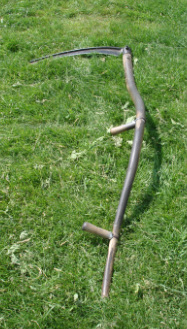 The following summer, one of these strange "Beasts" came to my farm. By that time, I was a member of the International Scythe Network, and taught scythe workshops, and also worked with people individually when they came out to my farm. A woman who was a avid market gardener, called me on the phone, and said she wanted to buy a new scythe. She had been using an old American style scythe for a couple of years, to make mulch for her garden, and she said that her neighbor could not stand to watch her work so hard anymore, and told her that if she was going to be that determined to use a scythe, she had buy a better scythe from Botan. I was curious about her American style scythe, and how she was working with it, so I asked her to bring it with her, and give me a demonstration.  When she arrived, I checked out the antique American scythe she had brought with her. It was quite heavy, and curvy, and crooked. I carefully tested the edge with my thumb. I didn't need to worry about cutting myself, because the blade was completely rounded off! I asked her if she had ever sharpened it, and she said no. I noticed that the tip of the blade was broken off. She said that she had hit it on a rock, and it had snapped off. (I have since seen a couple more American scythe blades with the tips broken off like this, from hitting our Wisconsin glacial rocks, and also some that had just bent in the middle, instead.) I tried a couple of tentative strokes with it, and could not get it to cut a thing, of course. So I asked her to show me how she mowed with it. She said that the scythe did not work very well with green grass, but she showed me her technique. Her technique was to wind up, and then take several very quick and very hard chops in succession, while moving sideways, like a crab, with each stroke. Then she would return to where she started, and take a small step forward, and repeat the procedure. She only managed to cut the bigger stems of grass. The rest was beaten down. She said mowing like that was a lot of work. I said yes, but she had gotten in great condition from it!  I then explained to her how my "Austrian" scythe blades were formed to work. I had taught several workshops by that point, and it seemed like no matter how thoroughly I explained how the scythe blade is supposed to cut, people's eyes would just glaze over, and then when I took them out mowing, they would automatically slash at the grass, just like in the pictures above. So I decided to try to simplify my explanation to the bare essentials, and my "3 curves" lecture was born. This turned into a highly effective teaching aid. Form equals function. I could show how the "Austrian" blades that I sell were formed in a way that you can see that they are indeed curved in three planes, and I would show the form with my hands. Then I would put the blades down on the ground, and while holding it by the tang, and slide the blade in an arc in front of me, and show the person how it was designed to cut the grass. Most people automatically assume that a scythe blade is used to slash at the vegetation, with the full length of the cutting edge impacting directly, and at once. The scythe blades that I sell are made to slide forward and cut at a shearing angle. No violent hacking is required. I can hold the tang of the blade with my hand, and simply slide it forward, in order to show how it shears and slices through the grass. Then I put the blade on a snath, and show them how it works with a snath. A good snath with two grips, enables you add a lot of force with great control to the mowing action, but it still works the same way as sliding it on the ground by hand. It just cuts a LOT more grass when on a snath! Even when attached to a snath, it's still a precision mowing tool. Mowing with a scythe is more like "shaving" the ground, than a tool for slashing at the vegetation. Then I turn it over to my student, and coach them on how to mow effectively with one of my scythes. I suggested that it might be more economical, at least in the short term, to get a new American blade for her snath, and if she sharpened it, she would get much better performance out of it than she had been. She said that even if she did, she thought she would still prefer the lighter weight and the performance of my Austrian scythe. There was no going back for her, she wanted one of my scythes. She also returned for additional workshops and equipment over the years.
1 Comment
Dean Vosler
9/1/2019 04:28:52 am
I purchase an American style scythe from anAmish owned store. I had no idea how to sharpen it, but thru the summer I eventually learned thru various websites. Unfortunately none were all inclusive. I have been able to clear a half an acre of goldenrod behind my house that was uncuttable with a string trimmer or lawnmower. It was able to grow for 2 months this spring due to the rain we had. Next spring I will be able to cut no matter how wet it is. A tip on sharpening the American style scythe. Get at wet grinder to put a thin concave sharp edge and get a convex sharpening stone to keep it sharp. This blade is tempered which allows it to remain sharp longer than a European scythe and doesn’t require daily peening to resharp it’s edge like a European scythe which is made of softer steel. As for the snathe being too heavy, mine is of aluminum and lighter and stronger than any wood snath. I also have a larger diameter aluminum snath with a shorter brush blade for cutting light brush. Anyone that tells you that using a scythe is not work has never used one or never cut tall grass and weeds. I read one comment that American grass and weeds were tougher than European grasses, thus the American scythe had to be heavier. I suspect it came about due to use for brush clearing and the ability to produce a better tempered steel than traditional European scythe which was peened to sharpen and form the thin blade.
Reply
Your comment will be posted after it is approved.
Leave a Reply. |
Botan AndersonArchives
March 2023
Categories
All
|

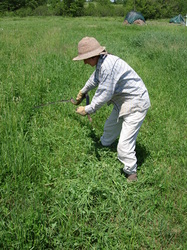

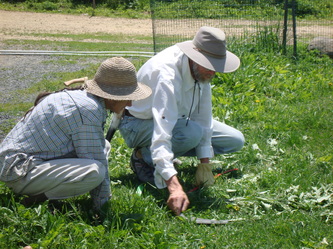
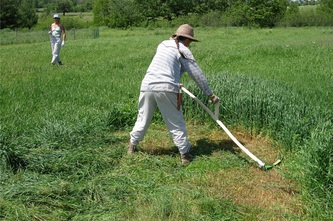
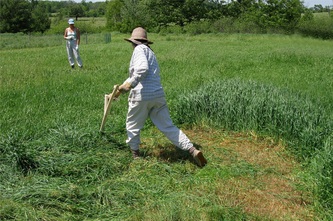
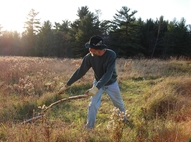
 RSS Feed
RSS Feed